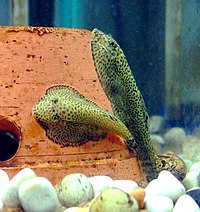
Photo from wikipedia
The effects of supplemental UV-A (385 nm) period and UV-A intensity for 5 days before harvest (DBH) on growth, antioxidants, antioxidant capacity, and glucosinolates contents in Chinese kale (Brassica oleracea… Click to show full abstract
The effects of supplemental UV-A (385 nm) period and UV-A intensity for 5 days before harvest (DBH) on growth, antioxidants, antioxidant capacity, and glucosinolates contents in Chinese kale (Brassica oleracea var. alboglabra Bailey) were studied in plant factory. In the experiment of the UV-A period, three treatments were designed with 10 W·m−2 UV-A supplement, T1(5 DBH), T2 (10 DBH), and no supplemental UV-A as control. In the experiment of UV-A intensity, four treatments were designed with 5 DBH, control (0 W·m−2), 5 w (5 W·m−2), 10 w (10 W·m−2), and 15 w (15 W·m−2). The growth light is as follows: 250 μmol·m−2·s−1; red light: white light = 2:3; photoperiod: 12/12. The growth and quality of Chinese kale were improved by supplemental UV-A LED. The plant height, stem diameter, and biomass of Chinese kale were the highest in the 5 W·m−2 treatment for 5 DBH. The contents of chlorophyll a, chlorophyll b, and total chlorophyll were only highly increased by 5 W·m−2 UV-A for 5 DBH, while there was no significant difference in the content of carotenoid among all treatments. The contents of soluble sugar and free amino acid were higher only under 10 DBH treatments than in control. The contents of total phenolic and total antioxidant capacity were the highest in 5 W·m−2 treatment for 5 DBH. There was a significant positive correlation between total phenolic content and DPPH and FRAP value. After 5 DBH treatments, the percentages and contents of total aliphatic glucosinolates, sinigrin (SIN), gluconapin (GNA), and glucobrassicanapin (GBN) were highly increased, while the percentages and contents of glucobrassicin (GBS), 4-methoxyglucobrassicin (4-MGBS), and Progoitrin (PRO) were significantly decreased, especially under 10 W·m−2 treatment. Our results show that UV-A LED supplements could improve the growth and quality of Chinese kale, and 5 W·m−2 UV-A LED with 5 DBH might be feasible for Chinese kale growth, and 10 W·m−2 UV-A LED with 5 DBH was better for aliphatic glucosinolates accumulation in Chinese kale.
Journal Title: Molecules
Year Published: 2022
Link to full text (if available)
Share on Social Media: Sign Up to like & get
recommendations!